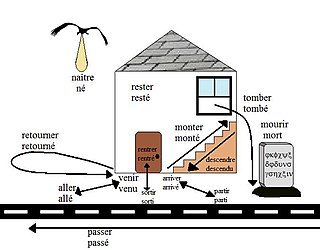Related Research Articles

Interlingua is an international auxiliary language (IAL) developed between 1937 and 1951 by the American International Auxiliary Language Association (IALA). It ranks among the most widely used IALs and is the most widely used naturalistic IAL – in other words, those IALs whose vocabulary, grammar and other characteristics are derived from natural languages, rather than being centrally planned. Interlingua literature maintains that (written) Interlingua is comprehensible to the hundreds of millions of people who speak Romance languages, though it is actively spoken by only a few hundred.

Interlingue, originally Occidental, is an international auxiliary language created in 1922 and renamed in 1949. Its creator, Edgar de Wahl, sought to achieve maximal grammatical regularity and natural character. The vocabulary is based on pre-existing words from various languages and a derivational system which uses recognized prefixes and suffixes.
French grammar is the set of rules by which the French language creates statements, questions and commands. In many respects, it is quite similar to that of the other Romance languages.
The subjunctive is a grammatical mood, a feature of the utterance that indicates the speaker's attitude towards it. Subjunctive forms of verbs are typically used to express various states of unreality such as: wish, emotion, possibility, judgment, opinion, obligation, or action that has not yet occurred; the precise situations in which they are used vary from language to language. The subjunctive is one of the irrealis moods, which refer to what is not necessarily real. It is often contrasted with the indicative, a realis mood which is used principally to indicate that something is a statement of fact.

Latino sine flexione, Interlingua de Academia pro Interlingua or Peano's Interlingua, is an international auxiliary language compiled by the Academia pro Interlingua under chairmanship of the Italian mathematician Giuseppe Peano (1858–1932) from 1887 until 1914. It is a simplified version of Latin, and retains its vocabulary. Interlingua-IL was published in the journal Revue de Mathématiques in an article of 1903 entitled De Latino Sine Flexione, Lingua Auxiliare Internationale, which explained the reason for its creation. The article argued that other auxiliary languages were unnecessary, since Latin was already established as the world's international language. The article was written in classical Latin, but it gradually dropped its inflections until there were none.

Spanish verbs form one of the more complex areas of Spanish grammar. Spanish is a relatively synthetic language with a moderate to high degree of inflection, which shows up mostly in Spanish conjugation.
Idiom Neutral is an international auxiliary language, published in 1902 by the International Academy of the Universal Language under the leadership of Waldemar Rosenberger, a St. Petersburg engineer.

Spanish is a grammatically inflected language, which means that many words are modified ("marked") in small ways, usually at the end, according to their changing functions. Verbs are marked for tense, aspect, mood, person, and number. Nouns follow a two-gender system and are marked for number. Personal pronouns are inflected for person, number, gender, and a very reduced case system; the Spanish pronominal system represents a simplification of the ancestral Latin system.
In linguistic typology, a null-subject language is a language whose grammar permits an independent clause to lack an explicit subject; such a clause is then said to have a null subject.
Italian grammar is the body of rules describing the properties of the Italian language. Italian words can be divided into the following lexical categories: articles, nouns, adjectives, pronouns, verbs, adverbs, prepositions, conjunctions, and interjections.
In French, a verb is inflected to reflect its mood and tense, as well as to agree with its subject in person and number. Following the tradition of Latin grammar, the set of inflected forms of a French verb is called the verb's conjugation.

This article presents a set of paradigms—that is, conjugation tables—of Spanish verbs, including examples of regular verbs and some of the most common irregular verbs. For other irregular verbs and their common patterns, see the article on Spanish irregular verbs.
French verbs are a part of speech in French grammar. Each verb lexeme has a collection of finite and non-finite forms in its conjugation scheme.
French conjugation refers to the variation in the endings of French verbs (inflections) depending on the person, tense and mood. Most verbs are regular and can be entirely determined by their infinitive form however irregular verbs require the knowledge of more than just the infinitive form known as the principal parts of which there are seven in French. With the knowledge of these seven principal parts of a verb one can conjugate almost all French verbs. However, a handful of verbs, including être, are highly irregular and the seven principal parts are not sufficient to conjugate the verb fully.

The passé composé is a past tense in the modern French language. It is used to express an action that has been finished completely or incompletely at the time of speech, or at some time in the past. The passé composé originally corresponded in function to the English present perfect, but now there is a tendency to use the tense for all completed actions in the past as the equivalent of the simple past. Its current usage corresponds fairly closely to that of the Latin perfect tense.
This article is an informal outline of the grammar of Interlingua, an international auxiliary language first publicized by IALA. It follows the usage of the original grammar text, which is accepted today but regarded as conservative.
A peculiarity of Venetian grammar is a "semi-analytical" verbal flexion, with a compulsory "clitic subject pronoun" before the verb in many sentences, "echoing" the subject as an ending or a weak pronoun. As will be clear from the examples below, Venetian subject clitics are neither "redundant" nor "pleonastic" because they provide specific information, not present on verbal endings. Independent/emphatic pronouns, on the contrary, are optional.
Intal is an international auxiliary language, published in 1956 by the German linguist Erich Weferling. Its name is an acronym for INTernational Auxiliary Language. Intal was conceived to unite the most important features of existing international auxiliary languages, like Esperanto, Ido, Occidental-Interlingue, Neo, Novial and Interlingua, into a compromise system.

Spanish object pronouns are Spanish personal pronouns that take the function of the object in the sentence. Object pronouns may be both clitic and non-clitic, with non-clitic forms carrying greater emphasis. When used as clitics, object pronouns are generally proclitic, i.e. they appear before the verb of which they are the object; enclitic pronouns appear with positive imperatives, infinitives, and gerunds. Non-clitic forms, by contrast, can appear anywhere in the sentence but can rarely be used without their clitic counterparts. When used together, clitic pronouns cluster in specific orders based primarily on person, and clitic doubling is often found as well. In many dialects in Central Spain, including that of Madrid, there exists the phenomenon of leísmo, which is using the indirect object pronoun le as the direct object pronoun where most other dialects would use lo (masculine) or la (feminine).
The language Interlingue, originally Occidental ([oktsidenˈtaːl]), is an international auxiliary language created in 1922 by Edgar de Wahl, who sought to achieve maximal grammatical regularity and natural character. The vocabulary is based on pre-existing words from various languages and a derivational system which uses recognized prefixes and suffixes.
References
- Pei, Mario. One Language for the World. Devin-Adair, New York: 1958.
- Stenström, Ingvar. "Que pote nos apprender ab le alteres e ab lor experientias de un seculo?" in Ingvar Stenström and Leland Yeager (joint authors), Tema: Interlinguistica e Interlingua, Discursos public. Union Mundial pro Interlingua, Netherlands: 1991. In Interlingua.